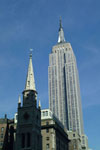Curriculum vitae

Curriculum vitae |

|
|
Name: Date of birth: Place of birth: Nationality: |
Alex David Greenwood February 5, 1968 Pittsburgh, Pennsylvania, U.S.A. U.S.A. |
|
Current work address: |
GSF-Forschungszentrum f�r Umwelt und Gesundheit Institut f�r Molekulare Virologie Geb 35, Raum 2028 Ingolst�dter Landstr. 1 85764 Neuherberg Deutschland |
|
Education: |
Bachelor of Arts, Genetics, Cornell University, Ithaca, New York, U.S.A. 1990 Ph.D. Human Genetics, University of Michigan, Ann Arbor, Michigan, U.S.A. 1996 |
|
Positions held: |
Research Associate, James A. Baker Institute for Animal Health, Cornell University, 1988-1990 NSF Alfred P. Sloan Postdoctoral Research Fellow, Zoological Institute, University of Munich, Munich, Germany, 1996-1999 Postdoctoral Research Fellow, Department of Vertebrate Zoology, American Museum of Natural History, New York, USA, 1999-2001 |
|
Current positions: |
Postdoctoral Research Fellow, Institute of Molecular Virology, GSF-National Research Center for Environment and Health, Munich, Germany Research Associate, Department of Vertebrate Zoology, American Museum of Natural History, New York, USA |
|
Languages spoken: |
English (spoken: native, written: native) German (spoken: fluent, written: basic) Spanish (spoken: fluent, written: basic) |
| Grants: |
National Science Foundation/Alfred P. Sloan Foundation, Grant number BIR-9626086 Postdoctoral Fellowship in Molecular Evolution, 1996-1998, National Science Foundation OPP 0117400, Megafaunal mammal genetics and extinction dynamics in the late Pleistocene: testing the hyperdisease hypothesis ($473,067; 2001-2003). Principal Investigator Ross MacPhee (Alex Greenwood and Robert DeSalle, Co-PIs) |
| Teaching: |
Teaching assistant: Human Genetics 541, Department of Human Genetics, University of Michigan, Ann Arbor, Michigan, 1995 Instructor: Extinctions in near time: causes, contexts, and consequences, American Museum of Natural History, New York, 1999-2000 |
|
Presentations at international meetings: |
May, 2000, Society for Conservation Biology, Montana, U.S.A. "Endogenous retroviruses of the woolly mammoth (Mammuthus primigenius)" July, 2000, Invited speaker, 5th International Ancient DNA Conference, Manchester, U.K., "Nuclear DNA of the woolly mammoth (Mammuthus primigenius)" October, 2000, Society of Vertebrate Paleontology, Mexico City, Mexico, "Genetics and paleontology" June, 2002, European Science Foundation, Retrotransposons: Their impact on organisms, genomes, and biodiversity. Helsinki, Finland, "Endogenous retroviruses of the woolly mammoth (Mammuthus primigenius)" May, 2003, European Science Foundation, Their impact on organisms, genomes, and biodiversity. Kranjska Gora, Slovenia, Poster: A novel CR1-like LINE element in anemone: Horizontal transfer between fish and coelenterates? Greenwood A.D., Seifarth W., Gebef�gi, E. and Leib-M�sch C |
| General press coverage of my research: |
Nicholas Wade. (October 29, 1999) Cloning of intact Siberian mammoth unlikely, expert says, citing fragmented DNA in earlier finds. The New York Times, No. 51,690 Evers, M., Korschow, M., and Sadownikowa, A. (1999) J�ger des faulen Fleisches. Der Spiegel, 50, 220-223 Stokstad, E. (2000) Hunting a mammoth killer. Science, 289, 531 Miller, M. (May 5, 2001) Mammoth mystery. New Scientist, No. 2289, 32-35 Calamai, P. 2004. Beyond "dreadful syncopation". Toronto Star, Sunday, November 7, p. A14. |